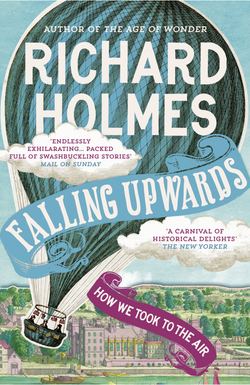Читать книгу Falling Upwards: How We Took to the Air - Richard Holmes - Страница 23
4
ОглавлениеThe year before Green’s epic flight, Edgar Allan Poe had written one of the earliest of his fantasy stories, ‘The Unparalleled Adventure of One Hans Pfaall’, published in the mass-circulation newspaper the New York Sun in June 1835. It is a highly technical and perversely well-imagined account of a successful ascent to the moon – in a home-made balloon of ‘extraordinary dimensions’, containing forty thousand cubic feet of gas.21
Pfaall’s lengthy preparations are given in great detail, his equipment including a specialised telescope, barometer, thermometer, speaking trumpet, ‘etc etc etc’, but also a bell, a stick of sealing wax, tins of pemmican, ‘a pair of pigeons and a cat’. Immediately upon launching, an explosion leaves him hanging upside down from a rope beneath the balloon basket. This proves to be a typically Poe-like state of horrific suspension (‘I wondered … at the horrible blackness of my finger-nails’) which would often be repeated in later stories.
Ingeniously recovering himself by hooking his belt buckle to the rim of the basket, Hans describes how his balloon, ascending ‘with a velocity prodigiously accelerating’, rapidly overtakes the record height achieved by ‘Messieurs Gay-Lussac and Biot’. He soon crosses ‘the definite limit to the atmosphere’. On the way he has another Poe-like vision into the centre of a stormcloud: ‘My hair stood on end, while I gazed afar down within the yawning abysses, letting imagination descend and stalk about in the strange vaulted halls, and ruddy gulfs, and red ghastly chasms of hideous and unfathomable fire.’
Hans succeeds in breaking out of the earth’s gravitational field, and uses a patent ‘air-condenser’ to breathe. But his ears ache and his nose bleeds. During nineteen days and nights, he observes the steadily retreating surface of the planet, gradually reduced to a curving globe of gleaming blue oceans and white polar ice caps: ‘The view of the earth, at this period of my ascension, was beautiful indeed … a boundless sheet of unruffled ocean … the entire Atlantic coasts of France and Spain … of individual edifices not a trace could be discovered, the proudest cities of mankind had utterly faded away from the face of the earth …’
He eventually floats upwards into the moon’s gravitational sphere, and begins to drift into lunar orbit. At this point the balloon turns round and begins a rapid descent towards the lunar surface. After landing, the balloonist is surrounded by an aggressive mob of small, ugly-looking creatures, ‘grinning in a ludicrous manner, and eyeing me and my balloon askance, with their arms set akimbo’.
After desultory greetings and unsatisfactory conversations, Hans turns from them ‘in contempt’, and lifts his eyes longingly above the lunar horizon. The version of ‘earthrise’ which follows is one of the most hauntingly poetic passages in the entire story. ‘Gazing upwards at the earth so lately left, and left perhaps forever, [Hans] beheld it like a huge, dull, copper shield, about two degrees in diameter, fixed immovably in the heavens overhead, and tipped on one of its edges with a crescent border of the most brilliant gold.’
Poe’s final, delicate irony is that the moon creatures do not believe the earth is inhabited. They think Hans Pfaall is a great and inveterate liar. And when, after a five-year lunar sojourn, he somehow contrives to get a message taken back across space by ‘an inhabitant of the Moon’ to the earth, addressed to the ‘States’ College of Astronomers in the city of Rotterdam’, they in turn dismiss Hans as a ‘drunken villain’, and his missive as ‘a hoax’. Poe’s readers are sardonically asked to draw their own conclusions.
Within less than a decade, Poe would return to the subject of balloons and amazing flights. This first pioneering tale, written when he was only twenty-six, is evidently inspired by Cyrano de Bergerac’s Histoire comique. But its technical originality and brilliance, its mixture of scientific realism and metaphysical terrors, suggests the wholly new dimension of science fiction.22
